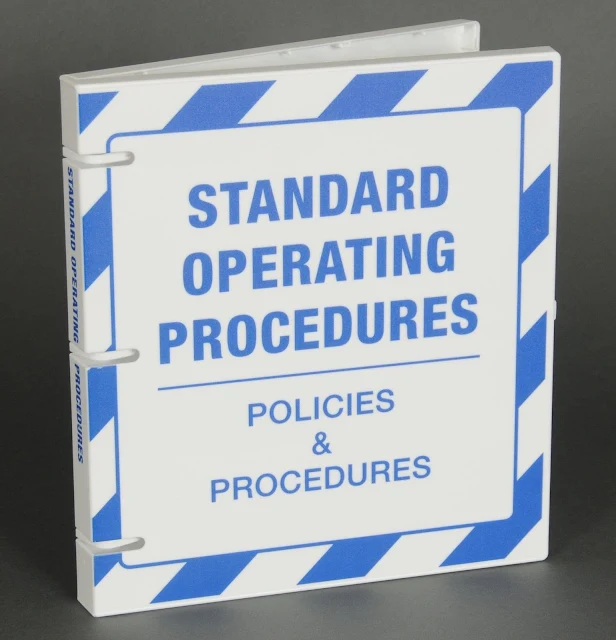Ad Code
Translate
List of 6,000+ Dofollow Commentluv Blogs FREE (Updated 2025)
January 16, 2025
What is Ozempic (semaglutide)? (Updated in 2025)
January 30, 2025
How To Find Suitable Properties In Cyprus? (Updated in 2025)
January 11, 2025
Smart strategies for trading on crypto exchanges
February 18, 2025
The importance of standard operating procedures
obaida shaikh
August 24, 2024
When it comes to business, efficiency is king. By cutting down the time for routine operations, you are actively creating room for innovation. Research has found several ways to optimize efficiency, but one that continues to be lauded as the most effective is having a set of standard operating procedures (SOPs).
Generally speaking, SOPs are a set of guiding standards that inform employees on how to do their jobs while keeping within the business’ standards. When appropriately created with business objectives and company culture kept in mind, this operating blueprint is a powerful tool for maximizing employee performance, organizational learning, and product quality. However, it’s crucial to understand the differences between standard operating procedures and work instructions. SOPs provide a broader framework, while work instructions delve into the specific, detailed steps of particular tasks. Recognizing this distinction can greatly enhance clarity and efficiency in your organization.
How can SOPs help your organization?
A learning organization performs better. SOPs are manuals of operations. They guide employees on how to conduct their day-to-day business while staying within the confines of business objectives. This manual serves as a critical driver of knowledge exchange between employees in different departments or at different levels. As one is promoted, they find a ready-made manual on their new role. This minimizes downtime in adjustment and gets them going quicker than if the manual was unavailable.
Furthermore, SOPs are living and breathing documents to be regularly updated with feedback from the employee on the job. Their feedback on essential tasks or changing elements within their roles is critical information for the organization to analyze, learn from, and adjust accordingly. As a result, you will have employees and an organization constantly learning from daily activities and documenting the changes in a document for everyone to read.
Product and service quality control maximizes profits and customer satisfaction.
When SOPs are followed closely, the business can be confident in the consistency of their service delivery or product. This consistency protects the product’s integrity, and in the 21st century, customers are looking for reliable and consistent service. An organization that employs SOPs to guide employees positions itself favorably to earn their trust and boost customer satisfaction, which is closely linked to increased sales.
Accurate monitoring and evaluation of employee performance equates to meaningful growth.
SOPs serve as “mirrors” for the employee. They give a set of clearly stipulated standards of procedures, which can later be used to measure performance. This apparent link between performance standards and daily practices is the basis of a transparent and objective performance review for the employee. Given the expectations, a supervisor can confidently sit and evaluate the employee objectively. Feedback from such a process is critical for making necessary changes in the role to improve performance and learning about strategies that work well to leverage those for better organizational performance.
When creating your organization’s SOPs, here are things to consider
Who is your target audience?
If you find yourself curious about how to create a SOP, you need only follow the steps outlined below. First, you should determine who your target audience is. This is necessary because SOPs are targeted to a specific role. As such, it’s essential to consider the person currently in the position or the ideal candidate. You should consider their task complexity and what information is relevant for that particular role. This will help in creating actionable operational procedures pertinent to that role.
What are your desired outcomes?
In writing SOPs, consider the desired outcomes. They are the basis upon which you design the flow of information in the SOP. Communicate clearly the desired results and tie them to the operating guidelines for optimal understanding.
What are the operating guidelines?
This is the heart of your manual. It indicates how employees complete tasks and conduct themselves to achieve stipulated outcomes. Create a thorough list and leave room for employee feedback on any items you may have missed.
The language used Like any manual, SOPs should be concise and relevant to avoid misunderstandings. Avoid vague language or phrasing and clearly define the flow of procedures. This goes hand in hand with knowing the audience to whom the SOPs apply.
A tool to manage standard operating procedures
Now that you understand what SOPs are and their importance, you’re probably wondering, “What app should I use to create and manage my SOPs?”. After testing many of the available tools out there, I’d recommend Flowster for your SOP app. It’s super easy to use, and they even have a free plan (not a trial; it’s free for life!), so you can play around with it before deciding to upgrade.
Featured Post
12 Prominent new technologies and trends emerging in 2025
Khabza Mkhize-
April 02, 2025
Soapie Teasers
Sister Sites
Most Popular
List of 6,000+ Dofollow Commentluv Blogs FREE (Updated 2025)
January 16, 2025
Smart strategies for trading on crypto exchanges
February 18, 2025
Popular posts
List of 6,000+ Dofollow Commentluv Blogs FREE (Updated 2025)
January 16, 2025
Smart strategies for trading on crypto exchanges
February 18, 2025
Footer Menu Widget
Created By Blogspot Theme | Distributed By Gooyaabi Templates


Social Plugin